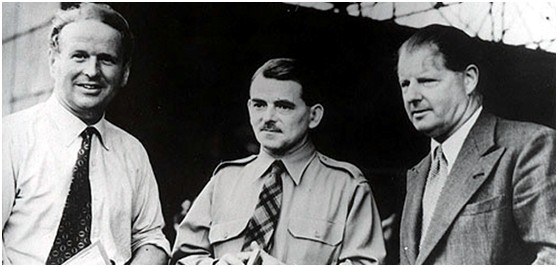
Cat's Eyes
USINFO | 2013-09-30 14:47

For weren’t carrots the reason Flight-Lieutenant Cunningham could see so well? So said Lord Woolton, the minister of food in the British government, who promised the nation their eyesight could be as good as Cunningham’s if only they ate enough carrots and stopped complaining about the lack of rationed meat. And what better way to encourage children to eat carrots than to tell them it’s the food of choice for heroes!
It was, of course, all nonsense, particularly for Cunningham, who bore his nickname stoically but was well aware of the real reason for his kill rate. “By May 1941 I had 12 successful combats in my Beaufighter,” he reflected after the war. “I was given the nickname, ‘Cat’s Eyes’ by the Air Ministry to cover up the fact that we were flying aircraft with radar because there was never any mention of radar at that period. So by the time I had had two or three successes, the Air Ministry felt they would have to explain that I had very good vision by night....it would have been easier had the carrots worked. In fact, it was a long, hard grind and very frustrating. It was a struggle to continue flying on instruments at night.”
What Cunningham called the “long, hard grind” had gathered pace during the summer of 1940 as Britain worked frantically on a radar system that could be used to detect the hordes of German aircraft attacking their shores. The AI [Airborne Interception] Mark III radar had been fitted in Blenheim aircraft during the Battle of Britain, but it was a crude system in an obsolescent craft, and so proved utterly ineffectual.
Then, in late September 1940, the AI Mark IV radar was introduced, along with the Beaufighter, an impressive two-seated aircraft with a top speed of 320 mph and an armament of four cannon and six machine guns. Cunningham described the Beaufighter as “the first real successful war machine that the [Royal] air force had for night fighting.”
The Mark IV radar was equally innovative, with a far more powerful transmitter than its predecessor that gave it greater range and allowed the Beaufighter’s radar operator to track enemy targets to within visual sight. He did so by looking through a leather visor at a small screen on which were two luminous green cathode tubes, one horizontal and the other vertical. The radar emitted a series of radio blips, and if an aircraft was within range an echo bounced back. It appeared on the green lines as a cluster of sparkling lights known as “blips.” One radar operator, sergeant Richard James of 29 squadron, recalled: “If the [target] aircraft climbed higher, the blip on the vertical tube got bigger so the operator told the pilot to climb. From the blip on the vertical tube you could see if the aircraft was port or starboard.”
The operator then issued instructions via the intercom to the pilot—increase throttle, decrease speed, etc.—until the blips sat squarely across the tubes. Now the aircraft’s blue exhaust flames were visible to the pilot. His first task was to confirm it was a “hostile,” which Cunningham always did by approaching from underneath so he could see the planform of the wing. The second task, once the pilot was sure it was a German aircraft, was to shoot it down.
On November 19, 1940 Cunningham scored the first success with the Mark IV radar during a Luftwaffe raid on the city of Birmingham. Flying a Beaufighter, he closed in on a Junkers 88. “I began to climb to its height very slowly and gently,” he recalled later. “We had to be very nearly at the same height and pointing at the enemy to use the gun sight and get the cannons to bear.”
Share this page



















